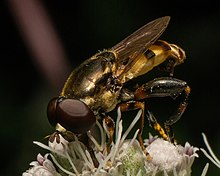| Tropidia albistylum | |
|---|---|

| |
| Tropidia albistylum | |
|
Scientific classification
| |
| Domain: | Eukaryota |
| Kingdom: | Animalia |
| Phylum: | Arthropoda |
| Class: | Insecta |
| Order: | Diptera |
| Family: | Syrphidae |
| Subfamily: | Eristalinae |
| Tribe: | Milesiini |
| Genus: | Tropidia |
| Species: | T. albistylum
|
| Binomial name | |
| Tropidia albistylum | |
Tropidia albistylum (Macquart, 1847), the Yellow-thighed Thickleg Fly, is a rare species of syrphid fly observed across the eastern and central United States. Hoverflies can remain nearly motionless in flight. The adults are also known as flower flies for they are commonly found on flowers, from which they get both energy-giving nectar and protein-rich pollen. The larvae are aquatic. [2]
It is found in the eastern United States and Canada, with records as far west as Nebraska and north to Norfolk County, Ontario. [3]
- ^ Macquart, Pierre-Justin-Marie (1847). Diptères exotiques nouveaux ou peu connus. 2.e supplement. Paris: Roret. pp. 5–104, 6 pls.
- ^ Skevington, J.H.; Locke, M.M.; Young, A.D.; Moran, K.; Crins, W.J.; Marshall, S.A (2019). Field Guide to the Flower Flies of Northeastern North America. Princeton Field Guides (First ed.). Princeton, New Jersey: Princeton University Press. p. 512. ISBN 9780691189406.
- ^ Dabrowski, Alice; Reynolds, Samm K.; Young, Andrew D. (2024). "First records of Tropidia albistylum Macquart (Diptera: Syrphidae) in Canada". The Journal of the Entomological Society of Ontario. 155 (jeso2024002). ISSN 1713-7845.
| Tropidia albistylum | |
|---|---|

| |
| Tropidia albistylum | |
|
Scientific classification
| |
| Domain: | Eukaryota |
| Kingdom: | Animalia |
| Phylum: | Arthropoda |
| Class: | Insecta |
| Order: | Diptera |
| Family: | Syrphidae |
| Subfamily: | Eristalinae |
| Tribe: | Milesiini |
| Genus: | Tropidia |
| Species: | T. albistylum
|
| Binomial name | |
| Tropidia albistylum | |
Tropidia albistylum (Macquart, 1847), the Yellow-thighed Thickleg Fly, is a rare species of syrphid fly observed across the eastern and central United States. Hoverflies can remain nearly motionless in flight. The adults are also known as flower flies for they are commonly found on flowers, from which they get both energy-giving nectar and protein-rich pollen. The larvae are aquatic. [2]
It is found in the eastern United States and Canada, with records as far west as Nebraska and north to Norfolk County, Ontario. [3]
- ^ Macquart, Pierre-Justin-Marie (1847). Diptères exotiques nouveaux ou peu connus. 2.e supplement. Paris: Roret. pp. 5–104, 6 pls.
- ^ Skevington, J.H.; Locke, M.M.; Young, A.D.; Moran, K.; Crins, W.J.; Marshall, S.A (2019). Field Guide to the Flower Flies of Northeastern North America. Princeton Field Guides (First ed.). Princeton, New Jersey: Princeton University Press. p. 512. ISBN 9780691189406.
- ^ Dabrowski, Alice; Reynolds, Samm K.; Young, Andrew D. (2024). "First records of Tropidia albistylum Macquart (Diptera: Syrphidae) in Canada". The Journal of the Entomological Society of Ontario. 155 (jeso2024002). ISSN 1713-7845.